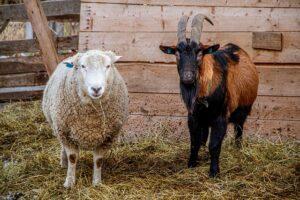Protecting domestic livestock is important: sheep and goat pox in the European Union
Sheep and goat pox regularly appear in some European countries. In June, the Romanian veterinary authority confirmed several outbreaks. The disease is not present in Hungary. In order to protect the Hungarian sheep and goat population, Dr. Szabolcs Pásztor, the National Chief Veterinary Officer, ordered increased monitoring of live small ruminant shipments. Nébih asks animal keepers to purchase animals only from legal sources and in a legal manner, and to immediately notify the service provider or official veterinarian in case of suspicion of disease.

(Photo: Pixabay)
Sheep and goat pox occurred widely in Europe, until the infection was eradicated by the end of the 1970s. However, since achieving immunity, the disease has appeared regularly in some European countries. The eradication of the 2022 Spanish epidemic – despite the rapid official measures – took almost a year. In Bulgaria, close to the Turkish border, the disease has been present since September 2023. In Greece, a major epidemic also began in the fall of 2023, as part of which outbreaks are still being reported today.
In Romania, the veterinary authority first detected the sheep and goat pox virus on 17 June 2025 in Teleorman County in southern Romania
During routine testing of two farms, a total of 702 sheep and 31 goats, the presence of the virus was identified in five samples. Due to the presence of sheep and goat pox and peste des petits ruminants, it is currently prohibited to transport live small ruminants to other Member States from Bulgaria, Greece and Romania. Recent outbreaks require increased vigilance from both the authority and animal keepers. In order to comply with the EU ban and thus protect the Hungarian sheep and goat population, Dr. Szabolcs Pásztor, the National Chief Veterinarian, has ordered increased control of the transport of live small ruminants from June 19, 2025. Nébih asks animal keepers to immediately notify their service provider or official veterinarian in case of suspicion in order to prevent and early detect sheep and goat pox! In addition, the authority asks Hungarian farmers and animal traders to strictly comply with the disease control rules and not to buy live animals of unknown origin!
Sheep and goat pox in brief
Sheep and goat pox occurs mostly in Southeast Europe, Africa and some areas of Asia. It is not dangerous to humans, but it can be a serious, even fatal disease in sheep and goats. Its symptoms include a red rash typical of smallpox, as well as fever, enlarged lymph nodes, eyelid swelling and serous-mucous nasal discharge. The rashes appear mainly on areas of the skin not covered by wool (head, armpits, abdomen, area under the tail), but in more severe cases they can extend to the entire body surface. The disease occurs after a 4-14-day incubation period, often attacking the lungs and udder, causing difficulty breathing and reduced milk production.
Nébih
Related news
AM: Government helps farmers with a loan moratorium
🎧 Hallgasd a cikket: Lejátszás Szünet Folytatás Leállítás Nyelv: Auto…
Read more >More than 100 Hungarian farmers also demonstrated in Brussels
🎧 Hallgasd a cikket: Lejátszás Szünet Folytatás Leállítás Nyelv: Auto…
Read more >NAK: Domestic producers await customers with an ample supply of all pine species
🎧 Hallgasd a cikket: Lejátszás Szünet Folytatás Leállítás Nyelv: Auto…
Read more >Related news
New Year’s Eve: shortened opening hours in stores – general store closure on January 1
🎧 Hallgasd a cikket: Lejátszás Szünet Folytatás Leállítás Nyelv: Auto…
Read more >Tejföl is only a name for live flora: new categories for sour dairy products will be introduced from 2026
🎧 Hallgasd a cikket: Lejátszás Szünet Folytatás Leállítás Nyelv: Auto…
Read more >Sausage prices before New Year’s Eve: cheap entry, expensive premium – how big is the gap on the shelves?
🎧 Hallgasd a cikket: Lejátszás Szünet Folytatás Leállítás Nyelv: Auto…
Read more >






